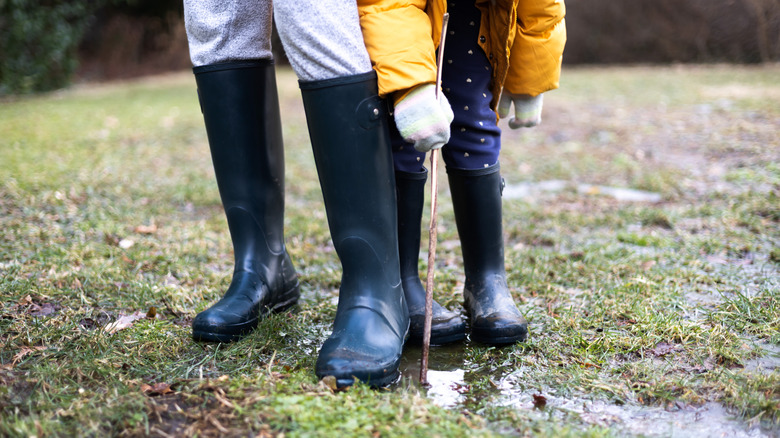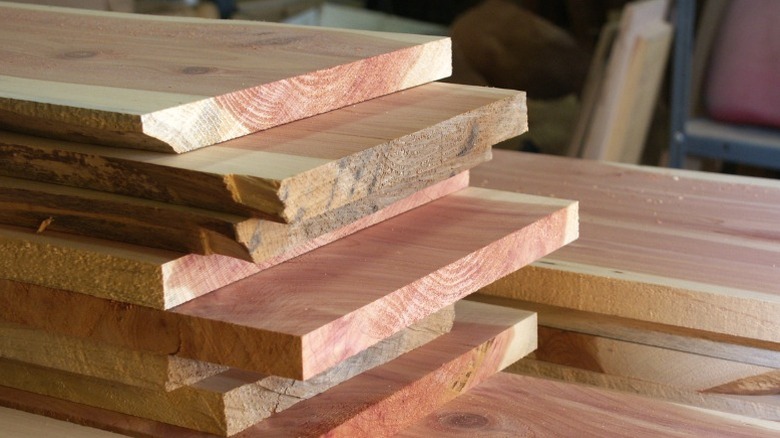Create A Simple Backyard Boardwalk To Protect Shoes And Feet From Muddy Grass
We may receive a commission on purchases made from links.
Walkways are one of the smartest additions to an outdoor layout, connecting points around the property for a cohesive aesthetic and providing a practical way to keep your feet clean as you walk around. And given how easy they can be to install, there's no reason to dismiss the idea of an attractive path for your backyard. We've seen how simple it can be to install a paver walkway. Yet you can go an even simpler (and cheaper) route by trading heavy stone blocks for lightweight wood planks, making your new path project a stress-free experience.
Instagrammer @theknottygarden brings us a stylish and sturdy DIY offering inspiration for a backyard wood path. Wood can be susceptible to rot and warping, so your path may not last as long as a stone or concrete walkway before needing maintenance. Nevertheless, it's a worthwhile compromise for the ease of installation, straightforward upkeep, and low cost these builds offer. There's no need to dig up the ground, lay a substrate, or move cumbersome blocks to get it to work. Instead, you just need to lay your path and add some surrounding fill. With only a few minutes of work, you'll have a perfectly functional route. And depending on the length of the walkway, you could finish the job using less than $100 worth of materials.
Tools and materials to make your backyard walkway
The four key materials needed to build your backyard boardwalk with this tutorial are landscaping fabric, wood boards, landscaping nails, and mulch. Get enough fabric, such as the EXTRAEASY Garden Weed Barrier Landscape Fabric ($9.99 for a 50-foot roll), to cover the path's length. To secure the boards against foot traffic, frost heave, and other forces, use landscaping nails, like the COBARYEN 10-Inch Landscape Anchoring Spikes ($24.38 for 50 pieces). Meanwhile, mulch creates a fill layer around the boards. Get enough to fill between the steps and create a few inches of border. Choose a quality garden mulch in a color to complement your wood walkway, or use gravel or rubber mulch for a longer-lasting fill layer.
For the walkway steps, untreated wood boards may last a couple of years before showing signs of rot, although some are more resilient. Cedar, cypress, and redwood are popular choices among the best woods for outdoor furniture and other projects. Like the designer in this video, you can use inexpensive cedar fence pickets and cut them to size. Or you can repurpose old or unused decking and other leftovers appropriate for outdoor use.
You could also use pressure-treated woods. Newer ACQ-treated lumber is more eco-friendly than previous varieties, giving you some reassurance when using it in the yard. If you opt for ground-contact-rated lumber, the wood can last several years before you notice any wear. Treated lumber isn't particularly attractive, though, so you may want to stain it to liven up the look.
Making a beautiful and practical boardwalk to protect your feet
Lay your landscaping fabric to create the path your boardwalk will follow, and cut your boards to the desired width to make them match. Place your boards, and measure the spacing until you land on a sensible layout. To set the boards in place, drill a pilot hole through the face of the board at both ends, where you can fit your landscaping nails. Consider using a jig if you want consistent hole placement between boards. Hammer the nails through the holes to secure a firm hold in the ground. You can then put the finishing touches on your project by applying mulch around the boards for a neat, well-defined path.
One concern with the wood boardwalk is the potential for slick steps. Protecting yourself from muddy grass following rain is nice, but slipping and falling is far worse than any amount of dirt you get on your shoes. Before you finish, adding an anti-slip coating can be a critical safety precaution. Spray products like Rust-Oleum Anti-Slip Spray make it effortless to provide surer footing, or you can use roll-on grit paint. Although it will require occasional adjustments, repairs, and replacements, this quick and easy approach to building a walkway is a savvy way to enhance your garden space with minimal effort.

